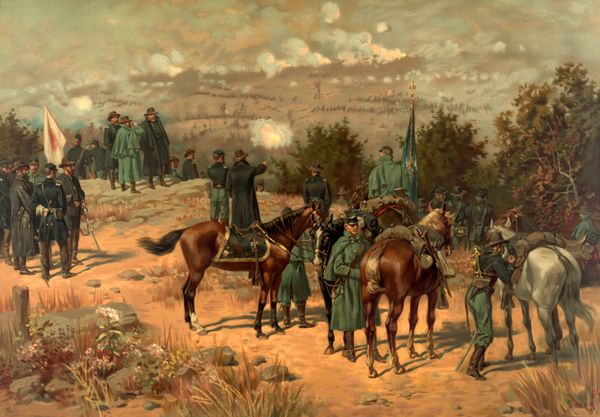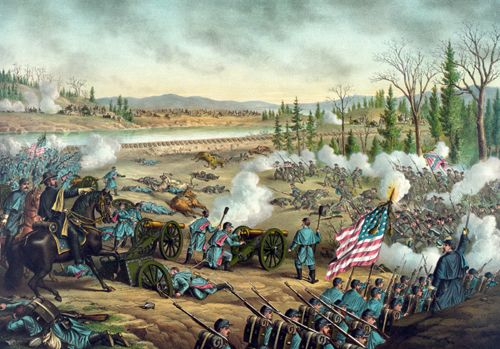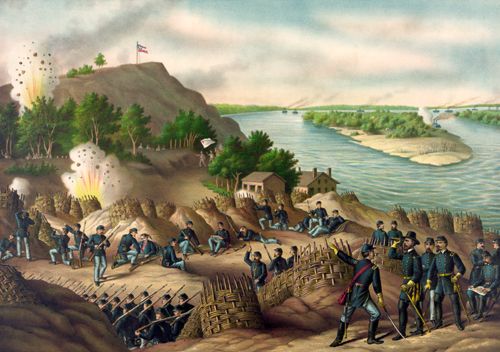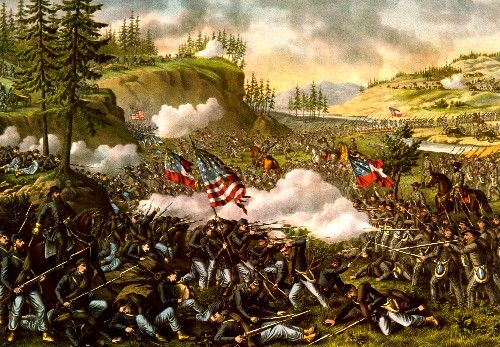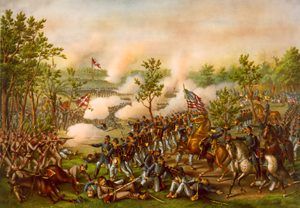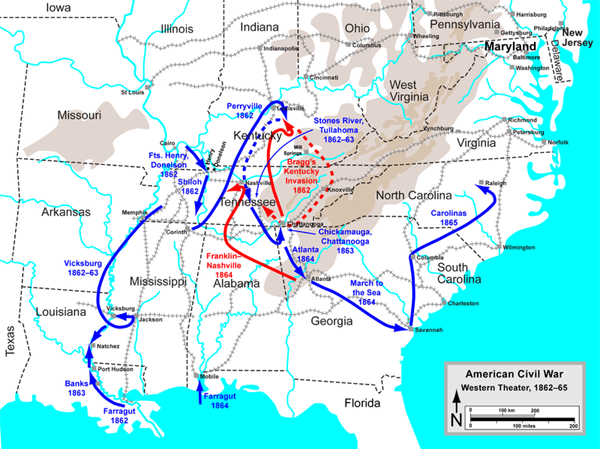
Western Theater Overview (1861–1865) (red=confederate, blue=union) Map courtesy of Wikipedia.
Defined both geographically and by campaign sequence, the Western Theater originally represented the area east of the Mississippi River and west of the Appalachian Mountains. However, the area expanded in 1864 when Major General William T. Sherman’s Union armies moved southeast from Chattanooga, Tennessee, into Georgia and the Carolinas. By some accounts, these campaigns were the most important of the Civil War, where a number of decisive battles were fought. When the Union invaded this immense area, the Confederacy was forced to defend with limited resources, major rivers that led directly to the agricultural heartland of the South. Starting in Kentucky and heading south down the Mississippi River, the Union then turned east through Tennessee, Georgia, and the Carolinas. Capturing the Mississippi River was a major turning point for the Union, and with the exception of just a few battles, the four years in the Western Theater marked a string of almost continuous defeats for the Confederacy.
Major Union commanders in the Western Theater included Lieutenant General Ulysses S. Grant, Major General Henry W. Halleck, Major General William T. Sherman, Major General George H. Thomas, Major General Don Carlos Buell, and Major General William Rosecrans. The Confederate troops were led by General Albert Sidney Johnston, General P.G.T. Beauregard, General Joseph E. Johnston, General Braxton Bragg, Lieutenant General John Bell Hood, and Lieutenant General Nathan Bedford Forrest.
Western Theater Campaigns
Operations in Eastern Kentucky – September-December 1861
Barbourville, Kentucky
Camp Wildcat, Kentucky
Ivy Mountain, Kentucky
Rowlett’s Station, Kentucky
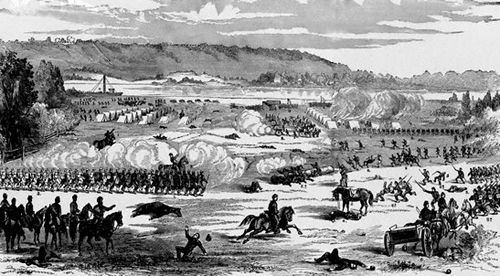
Federal forces commanded by Ulysses S. Grant assault Confederate forces commanded by Leonidas Polk at Belmont, Missouri, November 7, 1861.
Operations at the Ohio and Mississippi River Confluence – November 1861
Operations in Eastern Kentucky – January 1862
Middle Creek, Kentucky
Mill Springs, Kentucky
Federal Penetration up the Cumberland and Tennessee Rivers – February-June 1862
Fort Henry, Tennessee
Fort Donelson, Tennessee
Shiloh, Tennessee
Corinth, Mississippi
Joint Operations Against New Madrid, Island No. 10, and Memphis – February-June 1862
New Madrid, Missouri
Island No. 10, Missouri
Plum Run Bend, Tennessee
Memphis, Tennessee
Confederate Heartland Offensive – June-October 1862
Chattanooga, Tennessee
Murfreesborough, Tennessee
Richmond, Kentucky
Munfordville, Kentucky
Perryville, Kentucky
Iuka and Corinth Operations – September-October 1862
Siege of Corinth, Mississippi
Iuka, Mississippi
Corinth, Mississippi
Hatchie’s Bridge, Tennessee
Stones River Campaign – December 1862-January 1863)
Hartsville, Tennessee
Stones River, Tennessee
Forrest’s Expedition into West Tennessee – December 1862-January 1863
Lexington, Tennessee
Jackson, Tennessee
Trenton, Tennessee
Parker’s Cross Roads, Tennessee
Operations Against Vicksburg – December 1862-January 1863
Chickasaw Bayou, Mississippi
Arkansas Post, Arkansas
Grant’s Operations Against Vicksburg – March-July, 1863
Grand Gulf, Mississippi
Snyder’s Bluff, Mississippi
Port Gibson, Mississippi
Raymond, Mississippi
Jackson, Mississippi
Champion Hill, Mississippi
Big Black River Bridge, Mississippi
Siege of Vicksburg, Mississippi
Milliken’s Bend, Mississippi
Goodrich’s Landing, Louisiana
Helena, Arkansas
Middle Tennessee Operations – February-April, 1863
Dover, Tennessee
Thompson’s Station, Tennessee
Vaught’s Hill, Tennessee
Brentwood, Tennessee
Franklin, Tennessee
Streight’s Raid in Alabama – April 1863
Tullahoma or Middle Tennessee Campaign – June 1863
Hoover’s Gap, Tennessee
Morgan’s Raid in Kentucky, Indiana, and Ohio – July 1863
Corydon, Indiana
Buffington Island, Ohio
Salineville, Ohio
Chickamauga Campaign – August-September, 1863
Chattanooga, Tennessee
Davis’ Cross-Roads, Georgia
Chickamauga, Georgia
East Tennessee Campaign – September-October, 1863
Blountsville, Tennessee
Blue Springs, Tennessee
Reopening the Tennessee River – October 1863
Wauhatchie, Tennessee
Operations on the Memphis & Charleston Railroad – November 1863
Collierville, Tennessee – October 11, 1863
Collierville, Tennessee – November 3, 1863
Chattanooga-Ringgold Campaign – November 1863
Orchard Knob, Tennessee
Lookout Mountain, Tennessee
Missionary Ridge, Tennessee
Ringgold Gap, Georgia
Longstreet’s Knoxville Campaign – November-December, 1863
Campbell’s Station, Tennessee
Siege of Knoxville, Tennessee
Fort Sanders, Tennessee
Bean’s Station, Tennessee
Operations about Dandridge – December 1863-January 1864
Mossy Creek, Tennessee
Dandridge, Tennessee
Fair Garden, Tennessee
Operations in North Alabama – January 1864
Athens, Alabama
Meridian Campaign – February 1864
Meridian, Mississippi
Okolona, Mississippi
Demonstration on Dalton – February 1864
Dalton, Georgia
Forrest’s Expedition into West Tennessee and Kentucky – March-April, 1864
Paducah, Kentucky
Fort Pillow, Tennessee
Atlanta Campaign (May-September 1864)
The Atlanta Campaign followed the Union victory in the Battles for Chattanooga in November 1863. When Chattanooga, known as the “Gateway to the South,” was captured, it opened the gateway. After Ulysses S. Grant was promoted to general-in-chief of all Union armies, he left General William T. Sherman in charge of the Western armies. Grant’s strategy was to apply pressure against the Confederacy in several coordinated offensives. While he and other generals advanced in Virginia against Robert E. Lee, and General Nathaniel Banks attempted to capture Mobile, Alabama, Sherman was assigned the mission of defeating Confederate General Joseph E. Johnston’s army, capturing Atlanta, and striking through Georgia and the Confederate heartland.
The campaign consisted of a series of battles fought in the Western Theater throughout northwest Georgia and the area around Atlanta during the summer of 1864. Union Major General William T. Sherman invaded Georgia from the vicinity of Chattanooga, Tennessee, beginning in May 1864. Johnston’s Army of Tennessee withdrew toward Atlanta in the face of successive flanking maneuvers by Sherman’s group of armies. In July, Confederate President Jefferson Davis replaced Johnston with the more aggressive John Bell Hood, who began challenging the Union Army in a series of damaging frontal assaults. Hood’s army was eventually besieged in Atlanta, and the city fell on September 2, 1864, setting the stage for Sherman’s March to the Sea and hastening the end of the war.
The Union victory resulted in estimated casualties and losses of 31,687 Union, including 4,423 killed, 22,822 wounded, and 4,442 missing or captured. Confederate casualties were estimated at 34,979, which included 3,044 killed, 18,952 wounded, and 12,983 missing or captured.
Rocky Face Ridge, Georgia
Resaca, Georgia
Adairsville, Georgia
Dallas, Georgia
Pickett’s Mill, Georgia
Marietta, Georgia
Kolb’s Farm, Georgia
Kennesaw Mountain, Georgia
Peachtree Creek, Georgia
Atlanta, Georgia
Ezra Church, Georgia
Utoy Creek, Georgia
Dalton II, Georgia
Lovejoy’s Station, Georgia
Jonesborough, Georgia
Morgan’s Raid into Kentucky – June 1864
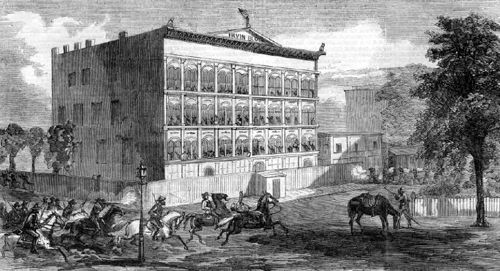
Confederate Major General Nathan B. Forrest’s raid on Memphis on August 21, 1864, by Harper’s Weekly.
Forrest’s Defense of Mississippi – June-August, 1864
Brice’s Cross Roads, Mississippi (June 10, 1864)
Tupelo, Mississippi (July 14-15, 1864)
Memphis, Tennessee (August 21, 1864)
Franklin-Nashville Campaign – September-December, 1864
Allatoona, Georgia
Decatur, Alabama
Johnsonville, Tennessee
Columbia, Tennessee
Spring Hill, Tennessee
Franklin, Tennessee
Murfreesboro, Tennessee
Nashville, Tennessee
Burbridge’s Raid into Southwest Virginia – October 1864
Saltville, Virginia
Breckenridge’s Advance into East Tennessee – November 1864
Bull’s Gap, Tennessee
Savannah Campaign – November-December, 1864
Griswoldville, Georgia
Buck Head Creek, Georgia
Honey Hill, South Carolina
Waynesborough, Georgia
Fort McAllister II, Georgia
Stoneman’s Raid into Southwest Virginia – December 1864
Marion, Virginia
Saltville, Virginia
Campaign of the Carolinas – February-April 1865
Rivers’ Bridge, South Carolina
Wyse Fork, North Carolina – March 7-10, 1865
Monroe’s Cross, North Carolina – March 10, 1865
Averasborough, North Carolina – March 16, 1865
Bentonville, North Carolina – March 19-21, 1865
Mobile Campaign – March-April, 1865
Spanish Fort, Alabama
Fort Blakely, Alabama
Mobile Bay, Alabama
Wilson’s Raid in Alabama and Georgia – April 1865
Tuscaloosa, Alabama
Ebenezer Church, Alabama
Selma, Alabama
Munford, Alabama
Compiled and edited by Kathy Weiser/Legends of America, updated June 2021.
Also See:
Eastern Theater of the Civil War
Civil War Trans-Mississippi Theater

